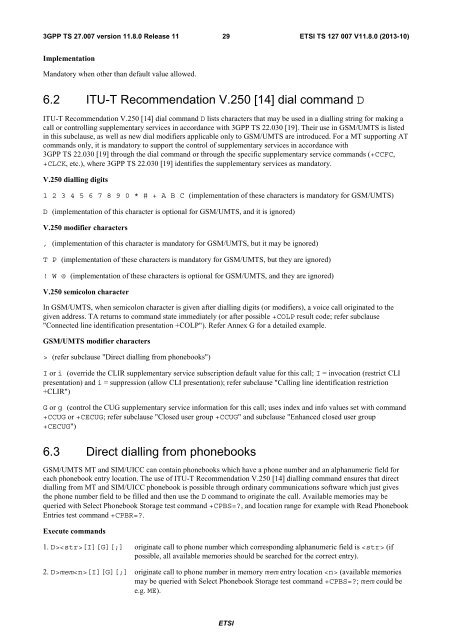ts_127007v110800p
ts_127007v110800p
ts_127007v110800p
Create successful ePaper yourself
Turn your PDF publications into a flip-book with our unique Google optimized e-Paper software.
3GPP TS 27.007 version 11.8.0 Release 11<br />
29<br />
ETSI TS 127 007 V11.8.0 (2013-10)<br />
Implementation<br />
Mandatory when other than default value allowed.<br />
6.2 ITU-T Recommendation V.250 [14] dial command D<br />
ITU-T Recommendation V.250 [14] dial command D lis<strong>ts</strong> characters that may be used in a dialling string for making a<br />
call or controlling supplementary services in accordance with 3GPP TS 22.030 [19]. Their use in GSM/UMTS is listed<br />
in this subclause, as well as new dial modifiers applicable only to GSM/UMTS are introduced. For a MT supporting AT<br />
commands only, it is mandatory to support the control of supplementary services in accordance with<br />
3GPP TS 22.030 [19] through the dial command or through the specific supplementary service commands (+CCFC,<br />
+CLCK, etc.), where 3GPP TS 22.030 [19] identifies the supplementary services as mandatory.<br />
V.250 dialling digi<strong>ts</strong><br />
1 2 3 4 5 6 7 8 9 0 * # + A B C (implementation of these characters is mandatory for GSM/UMTS)<br />
D (implementation of this character is optional for GSM/UMTS, and it is ignored)<br />
V.250 modifier characters<br />
, (implementation of this character is mandatory for GSM/UMTS, but it may be ignored)<br />
T P (implementation of these characters is mandatory for GSM/UMTS, but they are ignored)<br />
! W @ (implementation of these characters is optional for GSM/UMTS, and they are ignored)<br />
V.250 semicolon character<br />
In GSM/UMTS, when semicolon character is given after dialling digi<strong>ts</strong> (or modifiers), a voice call originated to the<br />
given address. TA returns to command state immediately (or after possible +COLP result code; refer subclause<br />
"Connected line identification presentation +COLP"). Refer Annex G for a detailed example.<br />
GSM/UMTS modifier characters<br />
> (refer subclause "Direct dialling from phonebooks")<br />
I or i (override the CLIR supplementary service subscription default value for this call; I = invocation (restrict CLI<br />
presentation) and i = suppression (allow CLI presentation); refer subclause "Calling line identification restriction<br />
+CLIR")<br />
G or g (control the CUG supplementary service information for this call; uses index and info values set with command<br />
+CCUG or +CECUG; refer subclause "Closed user group +CCUG" and subclause "Enhanced closed user group<br />
+CECUG")<br />
6.3 Direct dialling from phonebooks<br />
GSM/UMTS MT and SIM/UICC can contain phonebooks which have a phone number and an alphanumeric field for<br />
each phonebook entry location. The use of ITU-T Recommendation V.250 [14] dialling command ensures that direct<br />
dialling from MT and SIM/UICC phonebook is possible through ordinary communications software which just gives<br />
the phone number field to be filled and then use the D command to originate the call. Available memories may be<br />
queried with Select Phonebook Storage test command +CPBS=, and location range for example with Read Phonebook<br />
Entries test command +CPBR=.<br />
Execute commands<br />
1. D>[I][G][;] originate call to phone number which corresponding alphanumeric field is (if<br />
possible, all available memories should be searched for the correct entry).<br />
2. D>mem[I][G][;] originate call to phone number in memory mem entry location (available memories<br />
may be queried with Select Phonebook Storage test command +CPBS=; mem could be<br />
e.g. ME).<br />
ETSI


